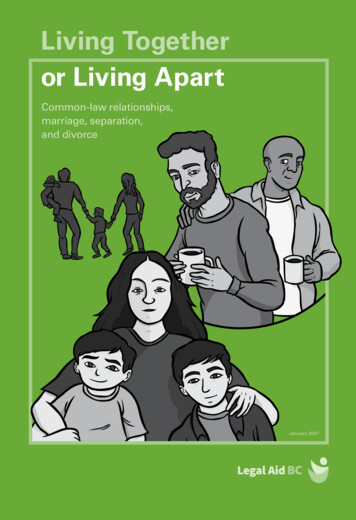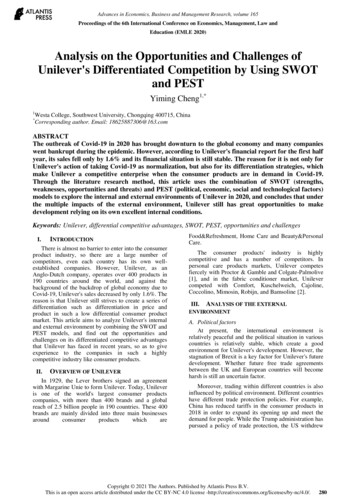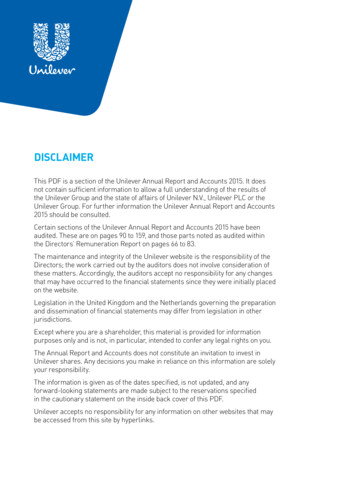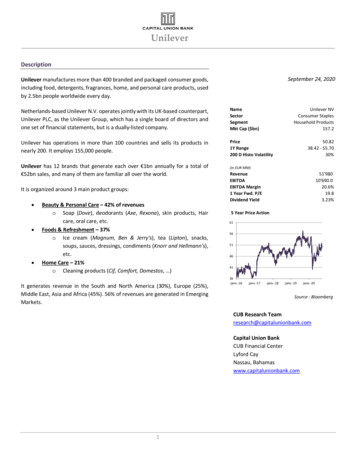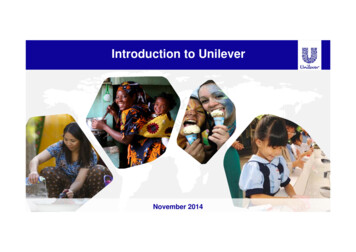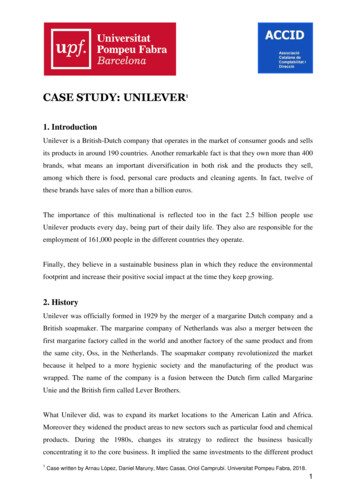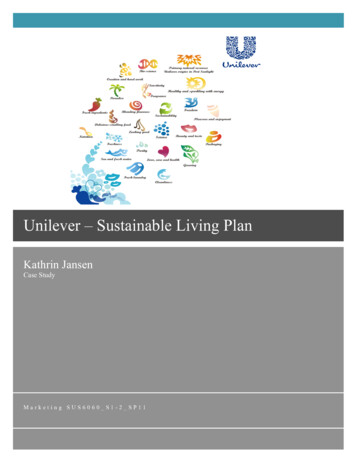
Transcription
Unilever – Sustainable Living PlanKathrin JansenCase StudyMarketing SUS6060 S1-2 SP11
2Unilever – Sustainable Living Plan1. Unilever – History and Mission“160 million times a day somewhere someone chooses a Unilever product.” (Unilever, 2011).Unilever is a global corporation with over 400 consumer brands. Unilever products are in more than 180countries around the world. The company was created in 1930 by a merger of the Dutch company MargarineUnie and the British soap maker Lever Brothers. Both companies experienced a huge demand for their productsand hoped that a merger would allow them to import palm oil, their main raw material, more efficiently. A videoon the company’s website narrates the early history of Unilever. Unilever was founded in the midst of the GreatDepression and the company survived World War II before the economic growth of the 50s and 60s helped thecompany to expand its product portfolio and launch in new countries around the globe. Unilever continued todiversify in the 70s and strong sales in African countries balanced out decreasing revenue in Europe and theUnited States. With the acquisition of Lipton International Unilever became one of the largest tea businesses inthe world. In the 80s and 90s Unilever reduced its product categories from 50 to only 13 (Unilever, n.d.). Thistrend continued in the 2000s as Unilever focused on three main product areas: nutrition, personal and home care.In 2004 the company redefined its mission: “to meet everyday needs for nutrition, hygiene and personal carewith brands that help people look good, feel good and get more out of life” (Unilever, 2011).2. Unilever Moves Toward SustainabilityIn the 1990s, Unilever started to react to growing environmental pressure and consumer concerns. The companyset up a sustainable agricultural program, started water-preserving initiatives, sourced fish only from sustainablestocks, improved the nutritional quality of its food products, partnered with non-profit organizations such as theRainforest Action Network and co-founded the Roundtable on Sustainable Palm Oil.A global company such as Unilever does not only affect the environment but it is also affected by it. Thecompany sources 12% of its black tea and 6% its tomato supply worldwide; Unilever understands that climatechange, tightened environmental legislation, and increased consumer awareness have an impact on its business.Unilever focuses its sustainability efforts on four key areas: greenhouse gas emissions, water conservation,waste reduction and sustainable sourcing. The Unilever website gives customers a comprehensive overview ofthe various sustainability efforts the company is undertaking. Customers can find information on all facets ofUnilever’s sustainability efforts in the interactive charts on the website. In addition, one can read comprehensivearticles about partnerships and metrics the company has developed on this side. Like Nestle with its “CreatingShared Value” approach, Unilever’s language around sustainability has changed over time. For instance,sustainability is no longer just Unilever’s business, Unilever now shares that responsibility with its customersand suppliers by “inspiring billions of people to take small, every day actions that add up to a bigdifference.”(Unilever, n.d.)
Unilever – Sustainable Living Plan 3In March 2010, Unilever’s CEO Paul Polman announced a new vision: “to double the size of the business whilereducing the company's environmental impact" (Unilever, n.d.). Then in fall 2010, Unilever started a newinitiative called the “Sustainable Living Plan” (SLP): “Our plan isn’t just the right thing to do for people and theenvironment. It’s also right for Unilever: the business case for integrating sustainability into our brands isclear.”(Unilever, n.d.) The company launched the 10-year SLP and its website with four simultaneous livedebates in London, Rotterdam, New Delhi and New York around the question: Can consumption becomesustainable?3. Thesis StatementThis paper examines if the SLP is a stringent continuation of Unilever’s sustainability efforts documented on itswebsite and assess if the SLP is a roadmap for the company’s 400 brands towards sustainability.4. Analysis of the Sustainable Living PlanSLP formulates three goals that it aims to reach by 2020: Help more than one billion people improve their health and well-being Halve the environmental impact of its products Source 100% of agricultural raw materials sustainablyThe SLP website is structured around these three goals and offers some metrics and examples on how to achievethe goals in the following areas: health and hygiene, nutrition, greenhouse gases, water, waste, sustainablesourcing, better livelihoods, and people. The SLP was well received by green blogs and sustainability experts(DiBenedetto, 2010), (Gunther, 2010). And at first glance, it looks like Unilever is a model of sustainability. Buta deeper analysis of the SLP reveals that the plan does not add anything new to the company’s currentsustainability efforts. The following analysis shows that the SLP is not a sustainability strategy, but a marketingtool, which encourages consumers to buy more of Unilever’s products. Most of the recommendations and the metrics on the SLP website are concerned with the footprint suppliersand consumers produce. For example, under the rubric “Water” one can read that water is a scare resourcethat needs to be protected (Unilever Sustainability, n.d.). Instead of making concrete goals on how Unileverplans to act on this issue customers learn: “But the water actually contained in products is just 7% of thetotal, compared to the 92% used by consumers.” (Unilever, n.d.). The subcategory “Manufacturing” is atestament of what the company has already done to reduce its water use. The company claims that newreductions are harder to accomplish since the company was already very progressive in this area (UnileverSustainability, n.d.)
4Unilever – Sustainable Living Plan Under the category “Hygiene” customers find information and can watch a video explaining how the use ofUnilever’s products (soaps, toothpaste and water purifier) enhances children’s life and prevents them fromdiarrhea. But nothing is said about the product itself: are its ingredients sustainably sourced, is theenvironmental impact on water less harmful then that of other soaps? Encouraging customers to wash handsis a reasonable effort, but diarrhea can be prevented with any soap not just Unilever’s. The “Product Analyzer” which is offered on the website claims to assess the environmental impact of 1600of Unilever’s products across their life cycles, is especially disappointing. The user learns, for example, thatthe largest water impact of a laundry product occurs while the consumer is washing clothes. The dataanalyzer does not give any information on how Unilever wants to lower the impact of its products, forexample, by making the laundry detergent less toxic or more efficient with less water. The reader of the SLPgets the impression that consumer impact (using the product) and supplier impact (providing raw materials)is so much larger that it would only make sense to start reducing here. The SLP cites only a few brands and their sustainability efforts. The category “Sustainable Sourcing”describes Unilever’s partnership with the Rainforest Action Network around sustainable cocoa farming. Thegoal is to source all cocoa sustainably for their brand Magnum by 2015. Currently it sources 6% of the totaldemand sustainably. This means they have to improve a lot to reach their goal by 2015. But instead ofdefining a clear roadmap towards that goal the customer is asked again: “Through the small act of buying anice cream that has ingredients which are sustainably sourced, consumers can enjoy small moments ofpleasure for themselves while helping to protect the environment and making others happy as well.”(Unilever Sustainability, n.d.) Since currently only a small part of the product is sourced sustainably,statements like this could be seen as greenwashing.Other Unilever brands and their sustainability efforts are mentioned only sporadically on the SLP website and itremains unclear how the company and its brands will achieve the above mentioned goals. Under the headline“ownership of our brands” Unilever offers support by identifying key priorities, but in the end the brands are“responsible and accountable for reaching our targets” (Unilever, n.d.). The SLP does not mention any concretestrategies or information on how individual brands are planning to become sustainable businesses.5. RecommendationsUnilever should use the SLP platform to state clearly how it will achieve its goal of becoming a “sustainablebusiness in every sense of the word” (Unilever, n.d.). The company should rephrase SLP’s goals and make themmore concrete and measurable.For example, Unilever could develop a metrics system or use an existing system, such as the Global ReportingInitiative (GRI) or the environment standard ISO 14001. Though the SLP uses some metrics it is very hard for
Unilever – Sustainable Living Plan 5customers to track those to see how much progress has been made. Unilever could adopt “Key PerformanceIndicators” that are similar to those Nestle developed, which are also comparable to the GRI indicators (Nestle,n.d.).A company representative answered questions about the SLP and what distinguishes it from Unilever’s currentefforts with the following statement: “What the plan allows us to do is to set comprehensive targets across thewhole organisation and focus the business on achieving them. In parallel with the external announcement is aninternal cascade across all our operations, so everyone with a role to play knows what is expected of them.”(Personal email communication with Flip Doetsch, April 19, 2011) Unilever should make at least some of theinternal plans available on the SLP website and help customers to understand how the company will achieve itsgoals.Lastly, Unilever should develop and communicate a sustainability strategy for its brands. A comprehensiveoverview of their performance in each sustainability category, concrete goals and steps towards reaching thosewould be a coherent continuation of Unilever’s efforts.6. ConclusionUnilever “wants to be a sustainable business in every sense of the word” (Unilever, n.d.). A careful analysis ofthe SLP revealed that it is not a continuation of the company’s existing sustainability efforts nor does it present agreen strategy for its 400 brands.From the above analysis it can be concluded that the company puts customers and suppliers in charge and istrying to minimize its own responsibility. Though the education of customers and suppliers is a laudable effortand should be integrated into every sustainability strategy, this alone is not enough for a company that claims totake its environmental responsibility seriously. The message SLP sends is: if customers use Unilever productsthey act sustainably. Recommending that people in the developing world use Lifebouy’s soap five times a day toprotect their children from diarrhea (Unilever Sustainability, n.d.) serves to increase sales without increasingUnilever’s sustainability efforts. In fact, the opposite is the case - increased sales will help Unilever to fulfill thefirst part of the vision the CEO announced last November: “Double the size of the business ”. But the SLPfails to articulate how the company will achieve the latter part: “ while reducing the environmental impact”. Itremains to be seen if Unilever refocuses on its sustainability efforts or continues to confuse customers with theSLP.
6Unilever – Sustainable Living Plan7. ReferencesCocoa. Unilever Sustainability. Retrieved April 11, 2011, from /sustainable-sourcing/cocoa/DiBenedetto, B. (2010, November 17). Unilever Commits to Halve Environmental Impact by 2020. TriplePundit. Retrieved April 10, 2011, from er, M. (2010, November 10). Inside Unilever’s Big, Broad, Bold Sustainability Plan Business GreenBiz.com. GreenBiz.com. Retrieved April 10, 2011, ashing. Unilever Sustainability. Retrieved April 9, 2011, from /health-hygiene/lifebuoy/Key Performance Indicators. Retrieved April 18, 2011, es/Key-Performance-Indicators.aspxManufacturing. Unilever Sustainability. Retrieved April 10, 2011, from /water/manufacturing/Unilever. (2011). Our brands Unilever Global. Brands for Life. Retrieved March 27, 2011, fromhttp://www.unilever.com/brands/Unilever. (2011). 2000s. Unilever Global. Retrieved March 28, 2011, 0s/?WT.LHNAV 2000sUnilever. Our history. Unilever Global. Retrieved April 3, 2011a, .GNAV Our historyUnilever. Sustainability. Unilever Global. Retrieved March 30, 2011b, V SustainabilityUnilever. Unilever Sustainable Living Plan. Retrieved March 23, 2011c, from http://www.sustainableliving.unilever.com/
Unilever – Sustainable Living Plan 7Unilever. Integrating sustainability into the business Unilever Sustainability. Retrieved April 10, 2011d, ness/Wate. Unilever Sustainability. Retrieved April 5, 2011, from /water/
Unilever focuses its sustainability efforts on four key areas: greenhouse gas emissions, water conservation, waste reduction and sustainable sourcing. The Unilever website gives customers a comprehensive overview of the various sustainability efforts the company is undertaking. Customers can find information on all facets of
